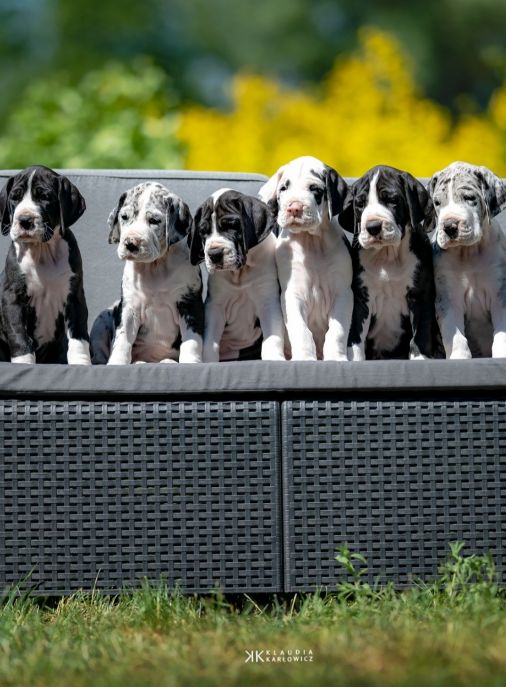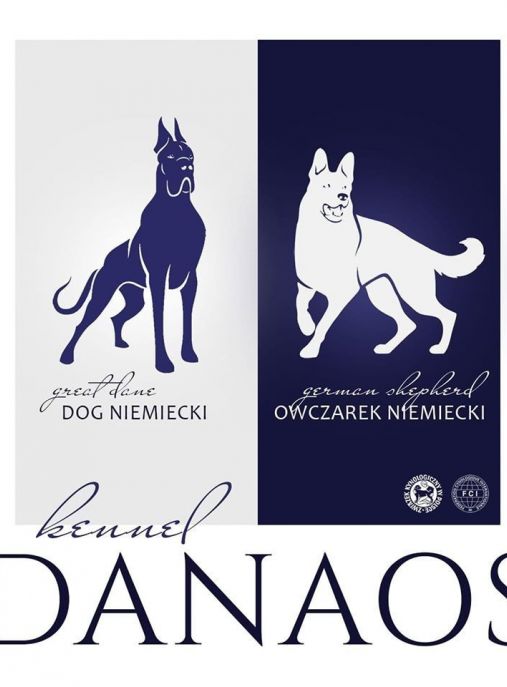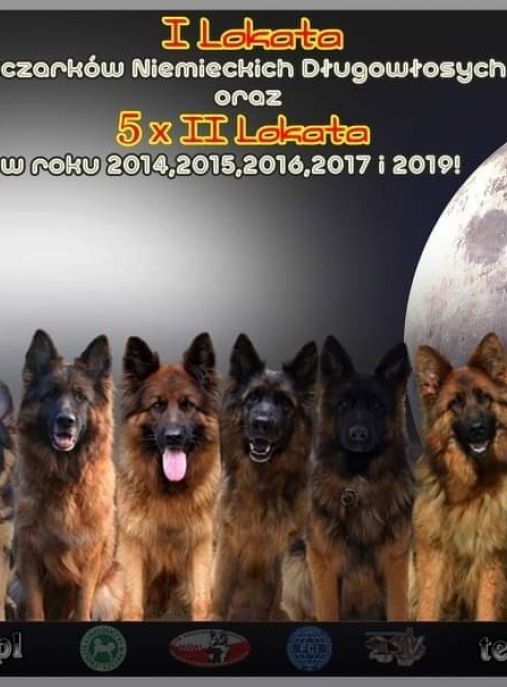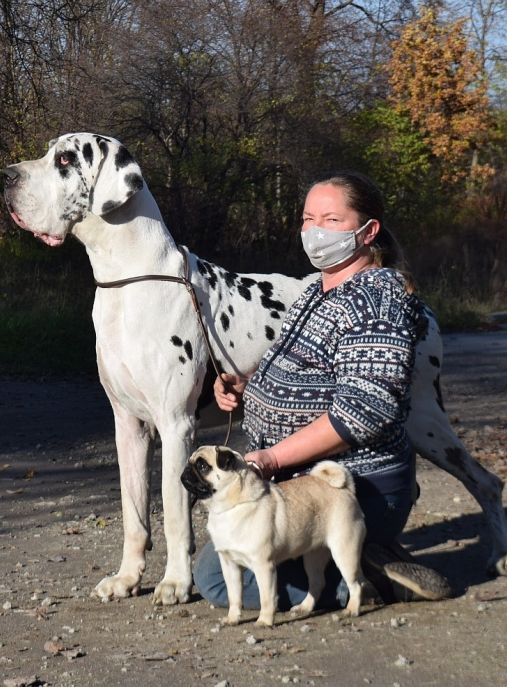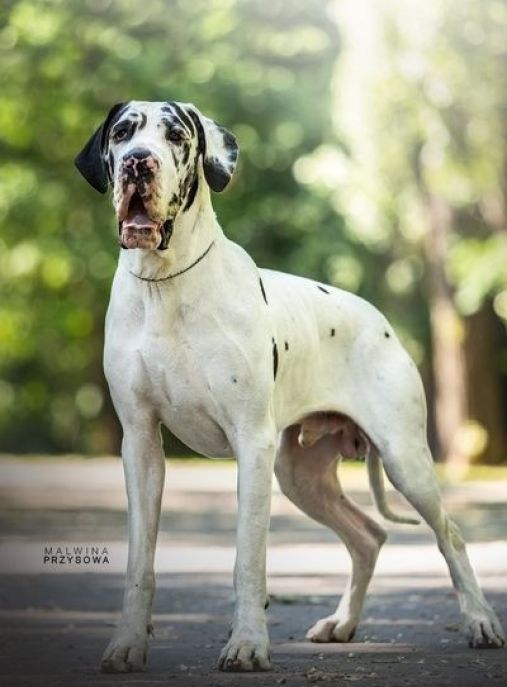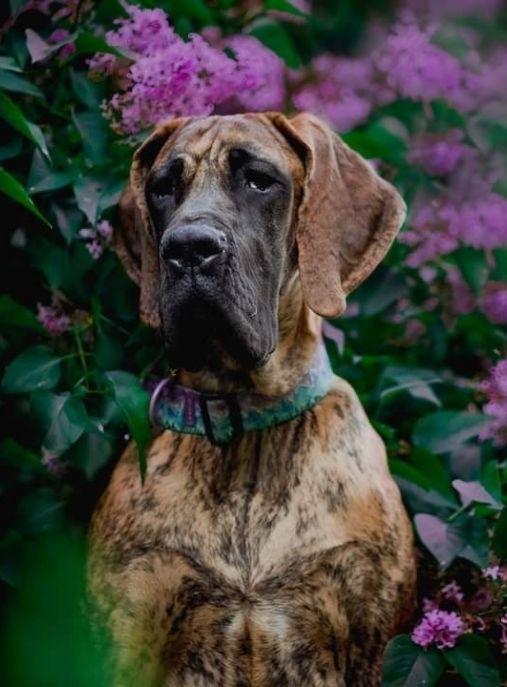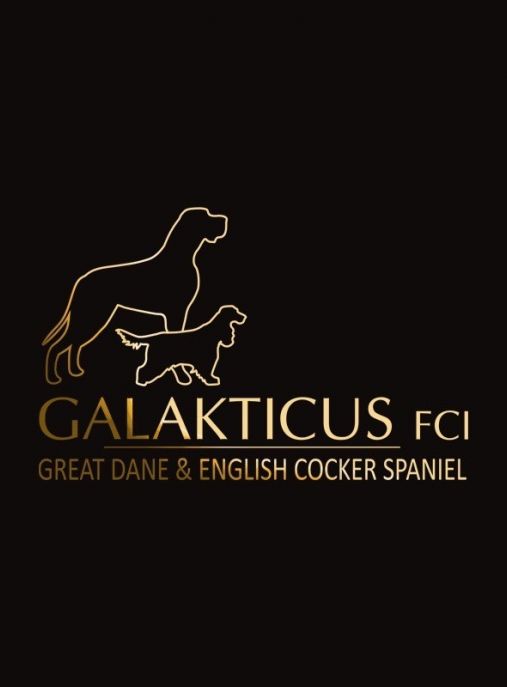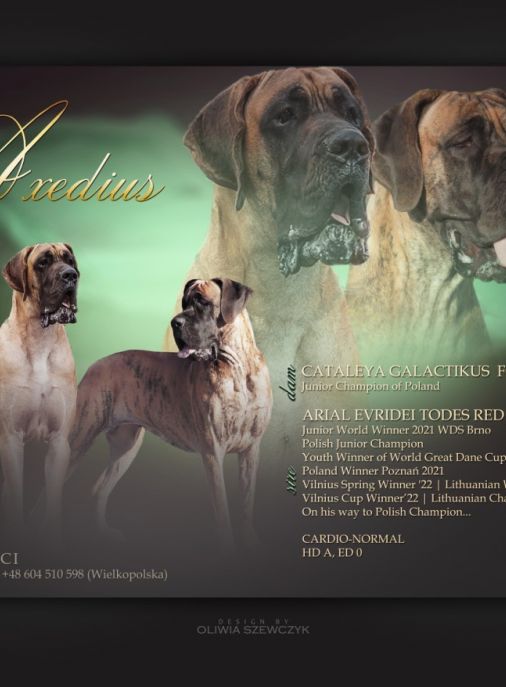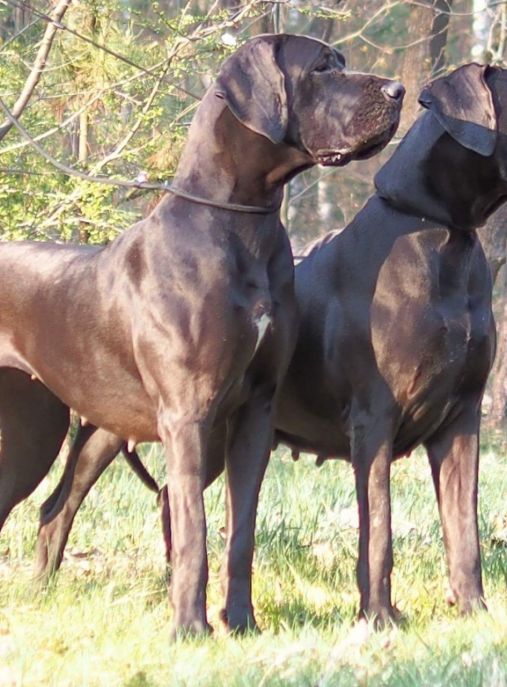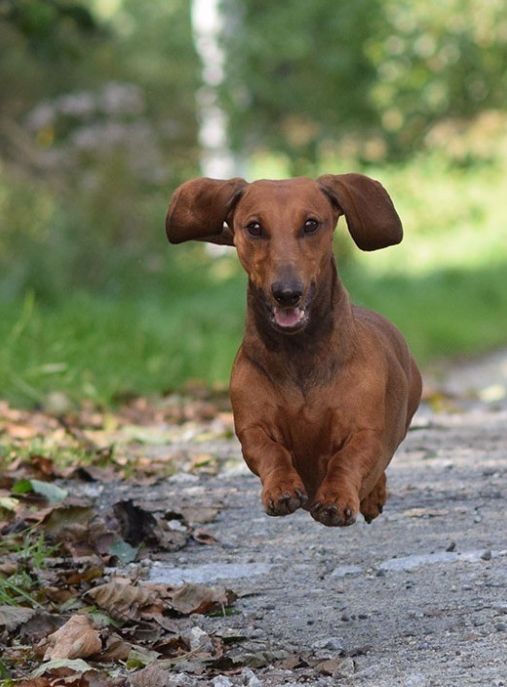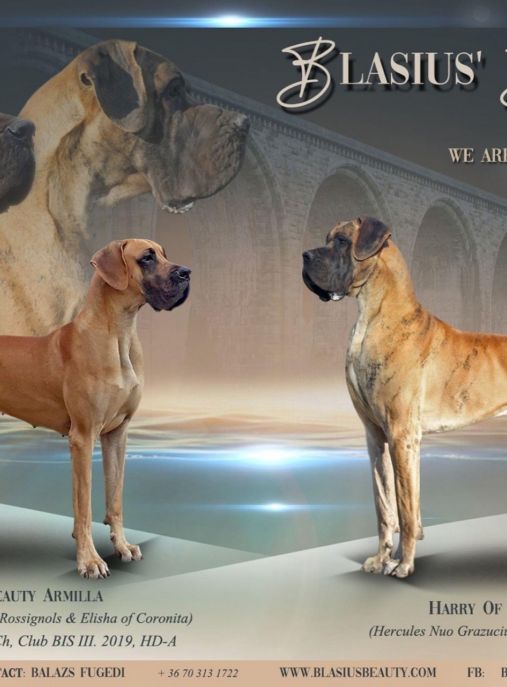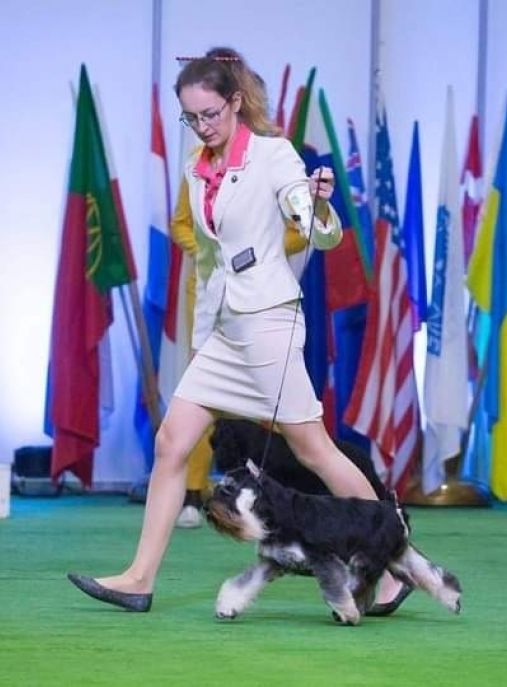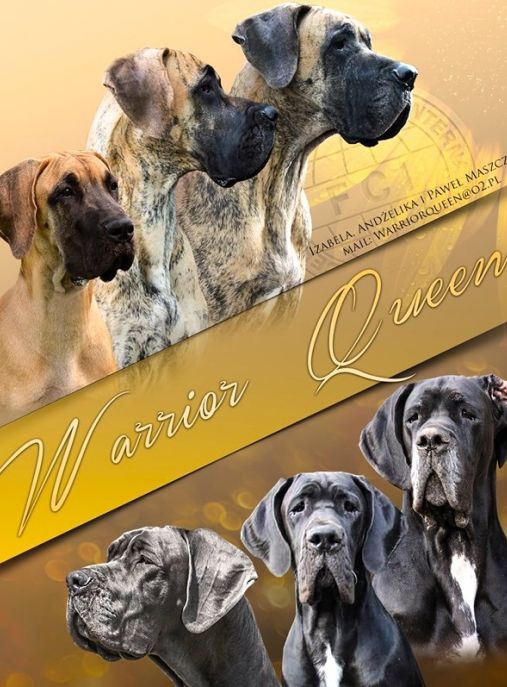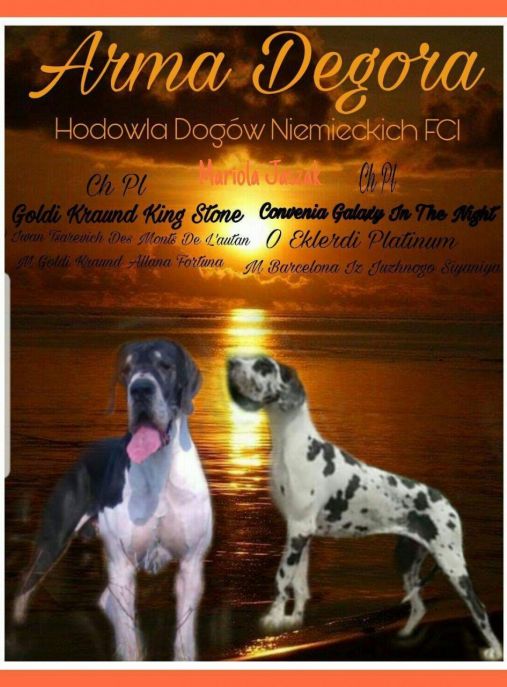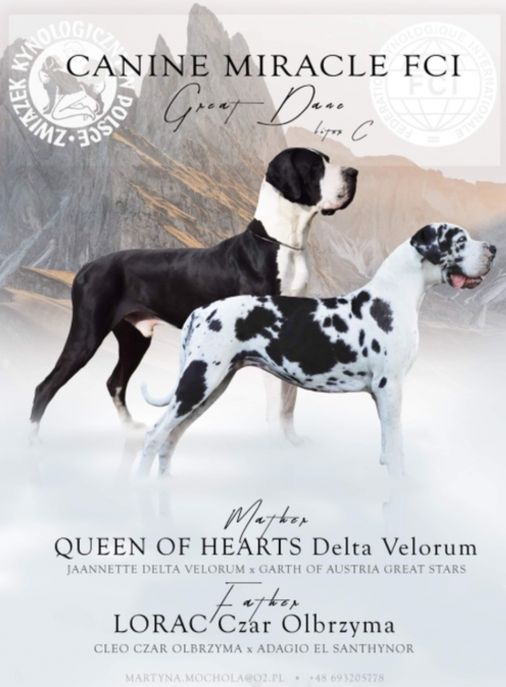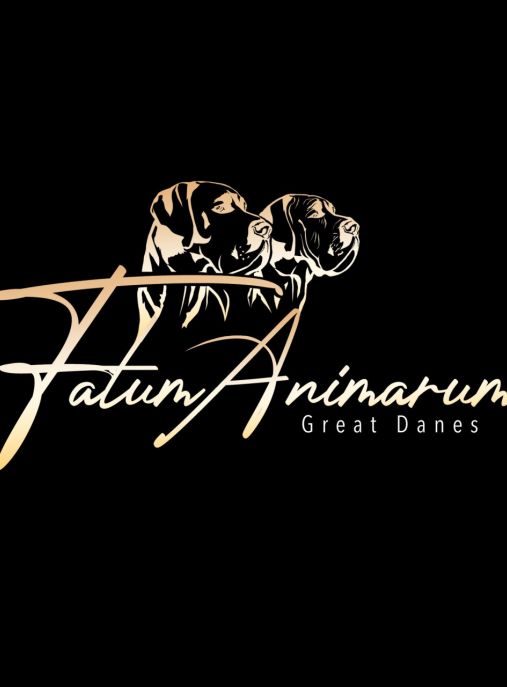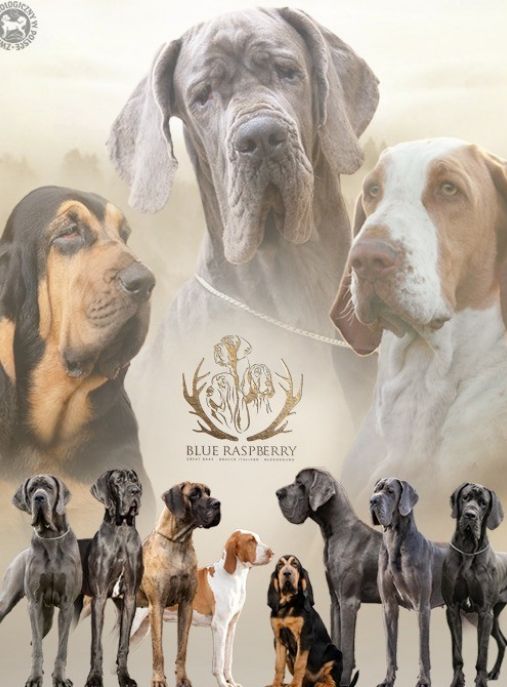The Great Dane, also known as the Deutsche Dogge or German Mastiff, is a majestic and powerful breed that captures the attention of all who encounter it. With its imposing size and regal appearance, the Great Dane stands as one of the tallest dog breeds in the world. This breed's noble and gentle nature, combined with its striking physical attributes, has made it a beloved companion and show dog for centuries.
The history of the Great Dane can be traced back to ancient civilizations, where similar large dogs were depicted in artwork and mentioned in historical texts. However, the breed as we know it today began to take shape in Germany during the 16th century. It is believed that the Great Dane was developed through the crossbreeding of English Mastiffs and Irish Wolfhounds, resulting in a dog with a unique blend of strength, agility, and grace.
According to the FCI (Fédération Cynologique Internationale) typology, the Great Dane belongs to Group 2: Pinscher and Schnauzer - Molossoid breeds - Swiss Mountain and Cattle Dogs. Within this group, the Great Dane is classified as a Molossoid breed, which includes other large and powerful dogs such as the Mastiff and the Saint Bernard.
Great Danes are known for their gentle and friendly nature, making them excellent family pets. Despite their imposing size, they are often described as "gentle giants" due to their calm and patient demeanor. They are highly sociable and thrive on human companionship, making them great with children and other pets when properly socialized.
In terms of physical characteristics, the Great Dane is a giant breed that can reach impressive heights. On average, males stand between 30 to 34 inches (76 to 86 cm) at the shoulder, while females are slightly smaller, ranging from 28 to 32 inches (71 to 81 cm). The weight of a Great Dane can vary greatly depending on its size and build, but it typically ranges from 110 to 175 pounds (50 to 79 kg) for males and 99 to 130 pounds (45 to 59 kg) for females.
The life expectancy of a Great Dane is relatively short compared to smaller breeds, with an average lifespan of 7 to 10 years. However, with proper care, nutrition, and regular veterinary check-ups, some Great Danes have been known to live up to 12 years or more. It is important to note that larger dog breeds often have shorter lifespans due to the strain their size puts on their bodies.
One interesting fact about Great Danes is their unique coat colors and patterns. They come in a variety of colors, including fawn, brindle, black, blue, harlequin, and mantle. The harlequin pattern, characterized by a white base coat with black patches, is particularly striking and sought after by many Great Dane enthusiasts.
Another notable characteristic of the Great Dane is its deep and resonant bark, which can be quite intimidating. While they are generally not excessive barkers, their powerful voice can be a deterrent to potential intruders. However, it is essential to provide proper training and socialization to ensure that their protective instincts are channeled appropriately.
Due to their size and exercise needs, Great Danes require ample space and regular exercise to maintain their physical and mental well-being. Daily walks, playtime, and access to a secure yard are essential for their overall health. Despite their large size, Great Danes are surprisingly adaptable and can thrive in various living environments, including apartments, as long as their exercise needs are met.
In conclusion, the Great Dane is a magnificent breed that combines strength, elegance, and a gentle nature. With its towering presence and loving disposition, it has earned a special place in the hearts of dog lovers worldwide. Whether as a loyal family companion or a show-stopping show dog, the Great Dane continues to captivate and inspire admiration for its remarkable qualities.
The Great Dane, also known as the "Apollo of dogs," is a majestic and noble breed that possesses a unique and captivating character. With their towering stature and gentle nature, Great Danes are often referred to as "gentle giants." In this text, we will delve into the character of Great Dane dogs, exploring their behavior, and providing insights on how to raise and train them.
One of the most prominent traits of Great Danes is their gentle and affectionate nature. Despite their imposing size, they are known for their friendly and loving disposition. Great Danes are incredibly loyal and form strong bonds with their families. They thrive on human companionship and are often referred to as "Velcro dogs" due to their tendency to stick close to their loved ones. This breed craves attention and enjoys being a part of family activities, making them excellent companions for households of all sizes.
Great Danes are generally well-mannered and have a calm demeanor. They are not known for being excessively hyperactive or aggressive. However, it is essential to provide them with proper socialization and training from an early age to ensure they grow into well-rounded adults. Early socialization helps them become comfortable with various people, animals, and environments, reducing the likelihood of fear or aggression later in life.
Training a Great Dane requires patience, consistency, and positive reinforcement. They are intelligent dogs and respond well to reward-based training methods. Harsh or punitive training techniques should be avoided as they can lead to fear or anxiety in these sensitive creatures. Early obedience training is crucial to establish boundaries and ensure they grow into well-behaved adults. Due to their size, leash training is particularly important to prevent them from pulling or becoming difficult to handle during walks.
Great Danes are generally good with children and can be excellent family pets. However, their large size means they may unintentionally knock over small children, so supervision is necessary during interactions. Additionally, due to their gentle nature, they may be more prone to separation anxiety if left alone for extended periods. Providing them with mental stimulation, exercise, and companionship can help alleviate this issue.
Exercise is an essential aspect of raising a Great Dane. Despite their size, they are not overly energetic dogs and have moderate exercise needs. Daily walks, playtime, and mental stimulation are necessary to keep them physically and mentally fit. However, it is important to avoid excessive exercise during their growth phase to prevent joint and bone issues. Consultation with a veterinarian regarding appropriate exercise routines is recommended.
Great Danes are generally good with other animals, including dogs and cats, especially if they are introduced to them at a young age. However, their size can be intimidating to smaller animals, so supervision and proper introductions are necessary.
In conclusion, Great Danes possess a gentle and affectionate character, making them wonderful companions for families. Their calm demeanor, loyalty, and love for human interaction make them a joy to be around. With proper socialization, training, and exercise, Great Danes can grow into well-behaved and balanced adults, enriching the lives of their owners with their majestic presence and unwavering devotion.
Great Danes are majestic and gentle giants, known for their imposing size and friendly nature. Caring for a Great Dane requires attention to their specific needs to ensure they live a healthy and happy life. Here are some tips on how to care for Great Dane dogs, including what to do and what not to do:
1. Nutrition:
Great Danes have unique dietary requirements due to their rapid growth and large size. Feed them high-quality, age-appropriate dog food that is specifically formulated for large breeds. Avoid overfeeding, as excessive weight gain can strain their joints and lead to health issues. Consult with a veterinarian to determine the right feeding schedule and portion sizes for your Great Dane.
2. Exercise:
Despite their size, Great Danes are relatively low-energy dogs. However, they still require regular exercise to maintain a healthy weight and prevent boredom. Daily walks and playtime in a secure, spacious area are essential. Avoid excessive exercise during their growth phase to prevent joint and bone problems. Remember to provide mental stimulation through interactive toys and training sessions.
3. Training and Socialization:
Early training and socialization are crucial for Great Danes. Start obedience training and socialization from a young age to ensure they grow into well-behaved and confident dogs. Positive reinforcement techniques work best with this breed, as they are sensitive and eager to please. Expose them to various environments, people, and animals to prevent fear or aggression issues later in life.
4. Grooming:
Great Danes have short, smooth coats that are relatively low-maintenance. Regular brushing with a soft-bristle brush helps remove loose hair and keeps their coat shiny. Check their ears weekly for signs of infection or excessive wax buildup. Trim their nails regularly to prevent discomfort and potential injuries. Lastly, maintain good dental hygiene by brushing their teeth regularly and providing dental chews or treats.
5. Health Care:
Regular veterinary check-ups are essential to monitor your Great Dane's overall health. Vaccinations, parasite prevention, and routine blood tests should be part of their healthcare regimen. Great Danes are prone to certain health issues such as hip dysplasia, bloat, and heart problems. Be vigilant for any signs of discomfort, such as limping, difficulty breathing, or a distended abdomen, and seek immediate veterinary attention if needed.
6. Environment:
Great Danes are indoor dogs and thrive in a loving and comfortable home environment. Provide them with a cozy bed or crate that accommodates their size. Ensure they have access to fresh water at all times, and keep their feeding area clean. Great Danes are sensitive to extreme temperatures, so avoid leaving them outside for extended periods in hot or cold weather.
7. Avoid Overexertion:
Due to their size, Great Danes are prone to joint and bone issues. Avoid activities that put excessive strain on their growing bodies, such as jumping from heights or running on hard surfaces. Discourage them from climbing stairs or jumping on and off furniture, as it can lead to injuries. Provide them with a comfortable and supportive bed to alleviate pressure on their joints.
8. Avoid Overfeeding Treats:
Great Danes have a tendency to gain weight easily, so it's important to avoid overfeeding treats. Treats should be given in moderation and should not exceed 10% of their daily caloric intake. Opt for healthy, low-calorie treats or use their regular kibble as rewards during training sessions.
Remember, each Great Dane is an individual, and their care may vary slightly. Always consult with a veterinarian for personalized advice and guidance on caring for your specific Great Dane. With proper care, love, and attention, your Great Dane will be a cherished companion for years to come.
The Great Dane, a majestic and regal breed, is known for its impressive size and striking appearance. When it comes to their coat color, Great Danes exhibit a wide range of hues, but one of the most common and iconic colors is the fawn coat.
The fawn color in Great Danes is a warm and earthy shade that exudes elegance and grace. It is characterized by a light tan or beige base, which can vary in intensity from a pale cream to a deeper golden hue. The fawn coat is often accompanied by a sleek and shiny texture, adding to the dog's overall allure.
One of the defining features of the fawn Great Dane is the presence of a black mask. This mask covers the dog's muzzle and extends to the eyes, creating a striking contrast against the lighter fawn coat. The mask can vary in intensity, ranging from a deep and solid black to a softer and more subtle shade. This black mask not only adds depth to the dog's facial expression but also enhances its noble and commanding presence.
In addition to the fawn coat and black mask, Great Danes may also exhibit black markings on their bodies. These markings can appear in various patterns, such as a black saddle-like marking on the back, black spots or patches on the body, or even a black-tipped tail. These black markings further enhance the dog's overall appearance, adding a touch of uniqueness and individuality.
The fawn color in Great Danes is not only visually appealing but also has a symbolic significance. It represents warmth, friendliness, and approachability. This color is often associated with a gentle and affectionate temperament, reflecting the breed's reputation as a loving and loyal companion.
It is important to note that while fawn is a common color in Great Danes, the breed also comes in other colors such as brindle, blue, black, harlequin, and mantle. Each color variation adds its own charm and allure to the breed, making Great Danes a truly diverse and captivating group of dogs.
In conclusion, the fawn coat in Great Danes is a beautiful and common color that showcases the breed's elegance and grace. With its warm tan base, black mask, and potential black markings, the fawn Great Dane exudes a regal and commanding presence. Whether seen in the show ring or as a beloved family pet, the fawn Great Dane is sure to capture the hearts of all who encounter its majestic beauty.
Great Danes are majestic and gentle giants known for their imposing size and friendly nature. Despite their regal appearance, they are prone to certain health issues that require special attention and care. Understanding the common diseases and taking proactive measures can help ensure the well-being of these magnificent dogs.
One of the most prevalent health concerns in Great Danes is hip dysplasia. This condition occurs when the hip joint doesn't develop properly, leading to discomfort, pain, and eventually arthritis. Regular exercise on soft surfaces, maintaining a healthy weight, and providing joint supplements can help manage this condition. Additionally, breeding dogs should undergo hip evaluations to reduce the risk of passing on this genetic predisposition.
Another common ailment in Great Danes is bloat, also known as gastric dilatation-volvulus (GDV). This life-threatening condition occurs when the stomach fills with gas and twists, cutting off blood supply. Symptoms include restlessness, unproductive vomiting, and a distended abdomen. Immediate veterinary attention is crucial, and preventive measures such as feeding multiple small meals, avoiding exercise after meals, and using elevated feeding bowls can help reduce the risk.
Heart disease is also prevalent in Great Danes, with dilated cardiomyopathy being the most common form. This condition causes the heart muscle to weaken, leading to an enlarged heart and potential heart failure. Regular cardiac screenings, a balanced diet rich in taurine and L-carnitine, and appropriate exercise can help manage this condition. Early detection and treatment are vital for a better prognosis.
Additionally, Great Danes are prone to certain genetic disorders, such as hypothyroidism, which affects the thyroid gland's ability to produce hormones. Symptoms include weight gain, lethargy, and skin issues. Regular thyroid screenings and lifelong hormone replacement therapy can help manage this condition effectively.
Care for the health of Great Danes involves several key aspects. Firstly, a balanced and nutritious diet is crucial to support their growth and overall well-being. Feeding high-quality dog food formulated for large breeds, avoiding excessive protein intake, and providing appropriate portion sizes can help prevent obesity and related health issues.
Regular exercise is essential for Great Danes, but it should be controlled to avoid excessive strain on their joints and bones. Moderate daily exercise, such as walks and playtime, is recommended, while high-impact activities like jumping or running on hard surfaces should be limited.
Routine veterinary check-ups are vital to monitor the dog's health and detect any potential issues early on. Vaccinations, parasite prevention, dental care, and regular screenings for breed-specific conditions should be part of the healthcare regimen.
Maintaining a healthy weight is crucial for Great Danes to prevent strain on their joints and reduce the risk of developing certain diseases. Monitoring their food intake, avoiding excessive treats, and providing regular exercise can help achieve and maintain an optimal weight.
Lastly, providing a safe and comfortable environment for Great Danes is essential. Their large size requires ample space to move around, and providing a cozy bed with proper support can help prevent joint issues. Regular grooming, including nail trimming, ear cleaning, and dental care, is also necessary to maintain their overall health.
In conclusion, while Great Danes are generally healthy dogs, they are prone to certain conditions that require special attention. By being aware of the common diseases, taking preventive measures, and providing proper care, Great Dane owners can ensure their beloved companions lead long, happy, and healthy lives.
The Great Dane, known for its majestic stature and gentle nature, requires a well-balanced and nutritious diet to support its growth and overall health. As a giant breed, Great Danes have unique nutritional needs that must be met to ensure their well-being. In this text, we will delve into the specifics of their nutrition, offering advice on what and how to feed these magnificent dogs while highlighting the things that should be avoided.
First and foremost, it is crucial to understand that Great Danes have a relatively short lifespan compared to smaller breeds. On average, they live for about 6-8 years, with some reaching up to 10 years. This shorter lifespan is partly due to their rapid growth rate during puppyhood, which puts strain on their bones and joints. Therefore, providing a proper diet from an early age is essential to support their growth and minimize potential health issues.
Protein is the foundation of any dog's diet, and Great Danes require a high-quality source of protein to support their muscle development. Look for dog food that contains real meat as the primary ingredient, such as chicken, beef, or fish. Avoid products that list meat by-products or fillers as the main ingredient, as these are of lower quality and provide less nutritional value.
While protein is crucial, it is equally important to maintain a balanced diet that includes carbohydrates and fats. Carbohydrates provide energy, and a moderate amount of whole grains, such as brown rice or oats, can be included in their diet. However, it is important to note that Great Danes have a relatively low metabolism, so excessive carbohydrates can lead to weight gain. Therefore, it is best to consult with a veterinarian to determine the appropriate carbohydrate levels for your dog's specific needs.
Fats are another essential component of a Great Dane's diet, as they provide energy and support healthy skin and coat. Look for dog food that contains healthy fats, such as omega-3 and omega-6 fatty acids, which can be found in fish oil or flaxseed. These fats also have anti-inflammatory properties, which can help reduce the risk of joint issues that are common in large breeds.
When it comes to feeding frequency, Great Danes should be fed multiple small meals throughout the day, rather than one large meal. This helps prevent bloating, a condition that can be life-threatening for deep-chested breeds like Great Danes. Additionally, it is important to monitor their weight and adjust their portion sizes accordingly. Obesity can exacerbate joint issues and other health problems, so maintaining a healthy weight is crucial.
While it is tempting to share our food with our furry friends, certain human foods can be toxic to dogs. Great Danes, like all dogs, should never be fed chocolate, grapes, raisins, onions, garlic, or anything containing xylitol, as these can be harmful or even fatal. Additionally, avoid giving them bones, as they can splinter and cause choking or internal injuries.
In conclusion, providing a well-balanced and nutritious diet is essential for the health and well-being of Great Danes. Focus on high-quality protein sources, moderate amounts of carbohydrates, and healthy fats. Feed them multiple small meals throughout the day, monitor their weight, and avoid feeding them toxic foods. By following these guidelines and consulting with a veterinarian, you can ensure that your Great Dane receives the nutrition it needs to thrive and live a long, healthy life.

